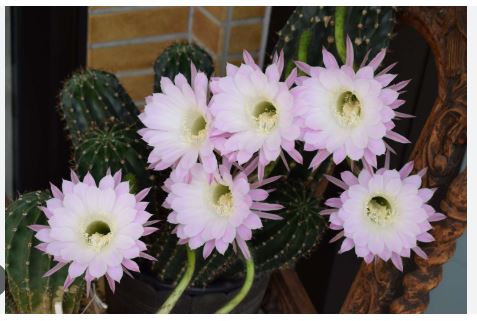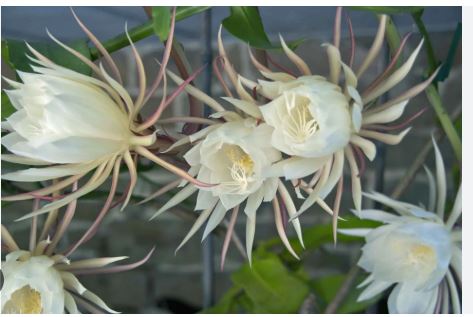
The term “Night Blooming Cereus” broadly refers to several cacti species known for their large, fragrant, nocturnal flowers that bloom briefly at night. These plants, often from different genera within the Cactaceae family, are celebrated for their spectacular blooms and are popular in cultivation.These plants, often sprawling or climbing, thrive in arid or tropical climates, storing water to endure harsh conditions. Their blooms, a rare spectacle, draw gardeners to cultivate them for ornamental drama. They adapt well to pots or gardens, needing minimal care in warm settings.
Their stems, typically green and segmented, range from slender to robust, with spines that vary in prominence. At night, large, fragrant flowers unfurl, glowing under moonlight and attracting pollinators like bats and moths. These blooms last mere hours, collapsing by dawn, sometimes leaving edible fruits. This ephemeral display captivates plant enthusiasts globally.
Native to warm regions, they flourish in deserts, forests, or rocky slopes, favoring well-drained soils. Cultivated worldwide in frost-free zones, they’re also grown indoors where winters are harsh. Their resilience to drought and poor soils makes them ideal for sustainable landscapes, blending beauty with hardiness.
In cultivation, they serve as striking accents, cascading over walls or brightening patios. Their flowers support nocturnal ecosystems, while fruits offer minor local sustenance. Beyond gardens, they carry cultural allure, symbolizing rarity and wonder. Night Blooming Cereus embodies nature’s ability to stun in the harshest settings.

Night Blooming Cereus
Selenicereus grandiflorus (Queen of the Night)
Native to Central America and the Caribbean, this climbing cactus has slender, green, 5–8-ribbed stems up to 10–20 feet (3–6 meters) long. Its spines are short and bristly. The white flowers, 10–12 inches (25–30 cm) wide, bloom at night in summer, exuding a vanilla-like scent, with small, red fruits following. Ideal for trellises or hanging baskets, it thrives in partial shade with well-draining soil, needing moderate water and protection from frost.
Selenicereus chrysocardium (Fern-Leaf Cactus)
Originating in southern Mexico, this epiphytic cactus features flat, deeply lobed, leaf-like stems 1–2 feet (30–60 cm) long, with no spines. Its creamy-white flowers, 8–10 inches (20–25 cm), open nocturnally in spring, faintly scented, producing rare fruits. Suited for shaded patios or indoor pots, it prefers humid conditions, loose soil, and regular watering, making it a favorite for tropical collections.
Selenicereus anthonyanus (Fishbone Cactus)
From Mexico’s rainforests, this epiphyte has zigzag, flat stems 1–3 feet (30–90 cm) long, resembling fishbones, with minimal spines. Its pinkish-white flowers, 6–8 inches (15–20 cm), bloom at night in late spring, lightly fragrant, with occasional small fruits. Perfect for hanging baskets, it grows in bright, indirect light with moist, well-drained soil, tolerating cooler nights above 50°F (10°C).
Selenicereus undatus (Dragon Fruit Cactus)
Native to Central and South America, this climbing cactus has thick, triangular, green stems 10–30 feet (3–9 meters) long, with tiny spines. Its white flowers, 10–14 inches (25–35 cm), bloom nocturnally in summer, yielding edible dragon fruit (red or yellow, sweet). Widely grown for fruit and ornament, it needs full sun, sturdy support, and well-drained soil, with moderate watering.
Hylocereus costaricensis (Costa Rican Dragon Fruit)
Found in Central America, this vigorous climber has 3-angled, green stems 6–20 feet (1.8–6 meters) long, with small spines. Its white flowers, 8–10 inches (20–25 cm), open at night in summer, producing red-skinned dragon fruit with vibrant red pulp. Cultivated for fruit and as an ornamental, it thrives in full sun, rich soil, and regular water, needing trellising for support.
Hylocereus monacanthus (Red-Fleshed Dragon Fruit)
Native to Colombia and Panama, this cactus has slender, triangular stems 5–15 feet (1.5–4.5 meters) long, with sparse spines. Its white, nocturnal flowers, 9–11 inches (23–28 cm), bloom in summer, followed by red fruits with sweet, red flesh. Grown for its tasty fruit and lush appearance, it prefers warm climates, well-drained soil, and partial shade, with consistent moisture.
Epiphyllum oxypetalum (Dutchman’s Pipe Cactus)
From Mexico and Central America, this epiphytic cactus has flat, scalloped, green stems 2–6 feet (60–180 cm) long, spineless. Its white flowers, 8–10 inches (20–25 cm), bloom at night in summer, with a strong, sweet fragrance, rarely fruiting. A classic houseplant, it excels in hanging pots with bright, indirect light, well-drained soil, and moderate watering, avoiding soggy conditions.
Epiphyllum anguliger (Fishbone Orchid Cactus)
Native to Mexico, this epiphyte has deeply lobed, flat stems 1–3 feet (30–90 cm) long, with no spines. Its creamy-white flowers, 6–8 inches (15–20 cm), open nocturnally in fall, mildly scented, with small, edible fruits. Ideal for indoor or shaded gardens, it grows in loose, organic soil, needing high humidity and regular water, thriving in warm, frost-free settings.
Peniocereus greggii (Arizona Queen of the Night)
Native to the southwestern U.S. and northern Mexico, this desert cactus has thin, gray-green stems 3–10 feet (0.9–3 meters) long, with short spines. Its white flowers, 6–8 inches (15–20 cm), bloom at night in early summer, faintly scented, producing red fruits. Suited for rock gardens, it needs full sun, gritty soil, and minimal water, tolerating drought and light frost.
Peniocereus striatus (Gearstem Cactus)
From Mexico’s Sonoran Desert, this slender cactus has wiry, 4–5-ribbed stems 2–6 feet (60–180 cm) long, with tiny spines. Its white, nocturnal flowers, 5–7 inches (12–18 cm), bloom in summer, with small, red fruits. Perfect for arid landscapes or pots, it requires well-drained soil, full sun, and infrequent watering, adapting to harsh, dry conditions.
Cereus hildmannianus (Hedge Cactus)
Originating in Brazil and Argentina, this columnar cactus grows 10–20 feet (3–6 meters) tall with 5–7-ribbed, blue-green stems, bearing short spines. Its white flowers, 6–8 inches (15–20 cm), open at night in summer, yielding red, edible fruits. Used in xeriscapes or as a fence, it thrives in full sun, poor soil, and minimal water, handling brief cold to 20°F (-6°C).
Harrisia jusbertii (Jusbert’s Night Blooming Cereus)
Native to Argentina, this sprawling cactus has 4–6-ribbed, green stems 3–10 feet (0.9–3 meters) long, with medium spines. Its white flowers, 6–7 inches (15–18 cm), bloom nocturnally in summer, producing yellow, spiny fruits. Grown for its blooms and compact form, it suits trellises or pots, needing bright light, well-drained soil, and moderate water, avoiding frost.